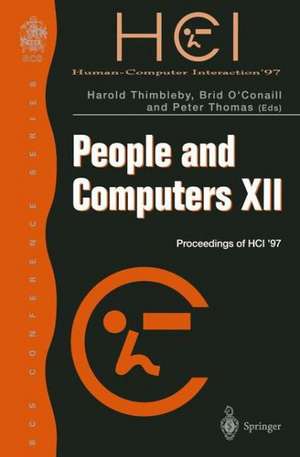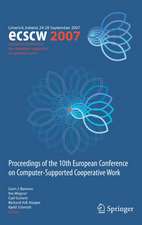People and Computers XII: Proceedings of HCI ’97
Editat de Harold Thimbleby, Brid O'Conaill, Peter J. Thomasen Limba Engleză Paperback – 15 aug 1997
Preț: 339.34 lei
Preț vechi: 424.17 lei
-20% Nou
Puncte Express: 509
Preț estimativ în valută:
64.95€ • 70.58$ • 54.60£
64.95€ • 70.58$ • 54.60£
Carte tipărită la comandă
Livrare economică 21 aprilie-05 mai
Preluare comenzi: 021 569.72.76
Specificații
ISBN-13: 9783540761723
ISBN-10: 3540761721
Pagini: 436
Ilustrații: XI, 420 p. 51 illus.
Dimensiuni: 155 x 235 x 23 mm
Greutate: 0.61 kg
Ediția:1st Edition.
Editura: SPRINGER LONDON
Colecția Springer
Locul publicării:London, United Kingdom
ISBN-10: 3540761721
Pagini: 436
Ilustrații: XI, 420 p. 51 illus.
Dimensiuni: 155 x 235 x 23 mm
Greutate: 0.61 kg
Ediția:1st Edition.
Editura: SPRINGER LONDON
Colecția Springer
Locul publicării:London, United Kingdom
Public țintă
ResearchCuprins
Making Passwords Secure and Usable.- Strategies for Organising Email.- Navigating Telephone-Based Interfaces with Earcons.- Do Users Always Benefit When User Interfaces Are Consistent?.- Conceptual Design Reconsidered: The Case of the Internet Session Directory Tool.- Computer Anxiety and the Human—Computer Interface.- Towards a Situated Action Calculus for Modelling Interactions.- Explorations in Sonic Browsing.- Remote Homeplace Communication: What is It Like and How Might We Support It?.- A Making-Movies Metaphor for Structuring Software Components in Highly Interactive Applications.- The Impact of Time and Place on the Operation of Mobile Computing Devices.- The Impact of Marginal Utility and Time on Distributed Information Retrieval.- Computer-Assisted Remote Control for the User with Motor Impairment.- Research and the Design of Human—Computer Interactions or ‘What Happened to Validation?’.- Using Diagrams to Support the Analysis of System ‘Failure’ and Operator ‘Error’.- The Interactional Affordances of Technology: An Ethnography of Human—Computer Interaction in an Ambulance Control Centre.- Why, What, Where, When: Architectures for Cooperative work on the World Wide Web.- BUILD-IT: A Computer Vision-based Interaction Technique for a Planning Tool.- Formally Comparing and Informing Notation Design.- Direct Object Manipulation vs Direct Concept Manipulation: Effect of Interface Style on Reflection and Domain Learning.- HyperAT: HCI and Web Authoring.- Separating User Knowledge of Domain and Device: A Framework.- Eliciting Information Portrayal Requirements: Experiences with the Critical Decision Method.- Author Index.- Keyword Index.


























